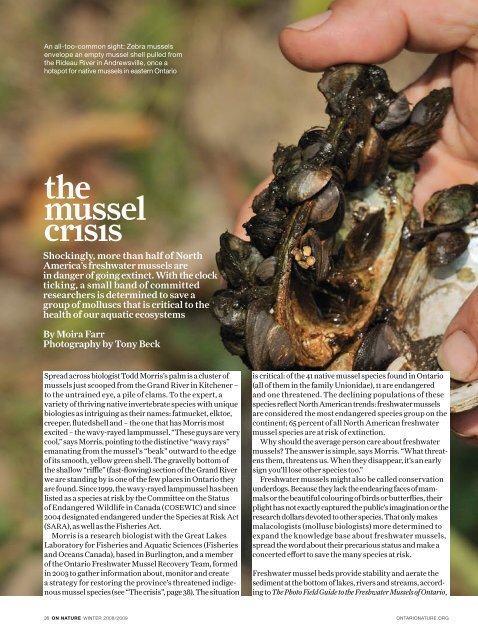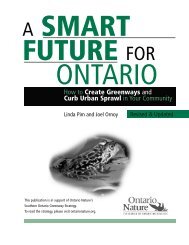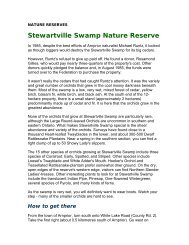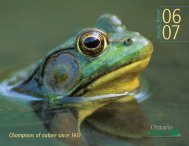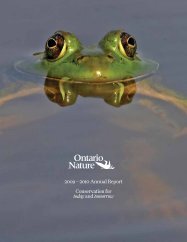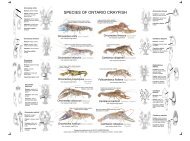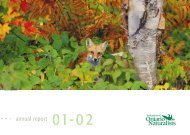The Mussel Crisis - Ontario Nature
The Mussel Crisis - Ontario Nature
The Mussel Crisis - Ontario Nature
You also want an ePaper? Increase the reach of your titles
YUMPU automatically turns print PDFs into web optimized ePapers that Google loves.
An all-too-common sight: Zebra mussels<br />
envelope an empty mussel shell pulled from<br />
the Rideau River in Andrewsville, once a<br />
hotspot for native mussels in eastern <strong>Ontario</strong><br />
Shockingly, more than half of North<br />
America’s freshwater mussels are<br />
in danger of going extinct. With the clock<br />
ticking, a small band of committed<br />
researchers is determined to save a<br />
group of molluscs that is critical to the<br />
health of our aquatic ecosystems<br />
By Moira Farr<br />
Photography by Tony Beck<br />
Spread across biologist Todd Morris’s palm is a cluster of<br />
mussels just scooped from the Grand River in Kitchener –<br />
to the untrained eye, a pile of clams. To the expert, a<br />
variety of thriving native invertebrate species with unique<br />
biologies as intriguing as their names: fatmucket, elktoe,<br />
creeper, flutedshell and – the one that has Morris most<br />
excited – the wavy-rayed lampmussel. “<strong>The</strong>se guys are very<br />
cool,” says Morris, pointing to the distinctive “wavy rays”<br />
emanating from the mussel’s “beak” outward to the edge<br />
of its smooth, yellow green shell. <strong>The</strong> gravelly bottom of<br />
the shallow “ri≠le” (fast-flowing) section of the Grand River<br />
we are standing by is one of the few places in <strong>Ontario</strong> they<br />
are found. Since 1999, the wavy-rayed lampmussel has been<br />
listed as a species at risk by the Committee on the Status<br />
of Endangered Wildlife in Canada (cosewic) and since<br />
2004 designated endangered under the Species at Risk Act<br />
(sara), as well as the Fisheries Act.<br />
Morris is a research biologist with the Great Lakes<br />
Laboratory for Fisheries and Aquatic Sciences (Fisheries<br />
and Oceans Canada), based in Burlington, and a member<br />
of the <strong>Ontario</strong> Freshwater <strong>Mussel</strong> Recovery Team, formed<br />
in 2003 to gather information about, monitor and create<br />
a strategy for restoring the province’s threatened indigenous<br />
mussel species (see “<strong>The</strong> crisis”, page 38). <strong>The</strong> situation<br />
is critical: of the 41 native mussel species found in <strong>Ontario</strong><br />
(all of them in the family Unionidae), 11 are endangered<br />
and one threatened. <strong>The</strong> declining populations of these<br />
species reflect North American trends: freshwater mussels<br />
are considered the most endangered species group on the<br />
continent; 65 percent of all North American freshwater<br />
mussel species are at risk of extinction.<br />
Why should the average person care about freshwater<br />
mussels? <strong>The</strong> answer is simple, says Morris. “What threatens<br />
them, threatens us. When they disappear, it’s an early<br />
sign you’ll lose other species too.”<br />
Freshwater mussels might also be called conservation<br />
underdogs. Because they lack the endearing faces of mammals<br />
or the beautiful colouring of birds or butterflies, their<br />
plight has not exactly captured the public’s imagination or the<br />
research dollars devoted to other species. That only makes<br />
malacologists (mollusc biologists) more determined to<br />
expand the knowledge base about freshwater mussels,<br />
spread the word about their precarious status and make a<br />
concerted e≠ort to save the many species at risk.<br />
Freshwater mussel beds provide stability and aerate the<br />
sediment at the bottom of lakes, rivers and streams, according<br />
to <strong>The</strong> Photo Field Guide to the Freshwater <strong>Mussel</strong>s of <strong>Ontario</strong>,<br />
36 on nature winter 2008/2009 ontarionature.org
Is it safe to eat freshwater mussels? Not a good idea. As filter feeders in water systems carrying many pollutants,<br />
mussels are probably filled with concentrated toxins. Besides, according to researcher Dave Zanatta, a Canadian<br />
malacologist now at the University of Central Michigan, people who have tried them say they taste like “mud-flavoured latex.”<br />
(It is illegal to collect live native mussels, or their shells, without a permit from the <strong>Ontario</strong> Ministry of Natural Resources.)<br />
an excellent reference book by Burlington-based, National<br />
Water Research Institute biologist Janice Metcalfe-Smith<br />
(with Alistair MacKenzie, the late Ian Carmichael and Daryl<br />
McGoldrick). Individual mussels can filter up to 40 litres<br />
of water a day. <strong>The</strong>y convert particles of organic material<br />
(including algae and bacteria), excreting phosphorus and<br />
nitrogen, which are important to other aquatic species such<br />
as plankton; they are a food source for fish, mammals and<br />
birds. Fish lay eggs in empty mussel shells, crayfish hide<br />
in them and insect larvae attach to them. <strong>The</strong>y can live for<br />
decades, but are extremely sensitive to pollution and habitat<br />
changes. By accumulating toxins, they serve as early indicators<br />
of environmental degradation.<br />
Native people harvested mussels, using them for food,<br />
jewellery and tools. Freshwater pearl hunting thrived in<br />
the 19th century. From the late 1800s until the 1940s, when<br />
plastics became commonplace, the Grand River supplied<br />
massive numbers of mussels to the button industry. Since<br />
the 1950s, freshwater mussel shells from the Mississippi<br />
River basin in the United States have been shipped in large<br />
quantities to Japan, where the shells are cut and placed inside<br />
oysters to produce cultured pearls.<br />
But the chief culprit in recent regional declines of<br />
freshwater mussels is the notorious zebra mussel, native<br />
to European bodies of water and believed to have been<br />
dumped into the St. Lawrence Seaway in the ballast water<br />
of an ocean vessel from the Caspian Sea. Since 1988, when<br />
biologist Gerald Mackie (now retired from the University<br />
of Guelph) identified the first members of this invasive<br />
species found in North America, on the shores of Lake St.<br />
Clair, they have done more than clog water pipes and<br />
become a nuisance to boaters. Zebra mussels – unlike<br />
members of the Unionidae family, which require host fish<br />
to reproduce – broadcast their larvae into the water, robbing<br />
other species of the nutrients and oxygen they need to<br />
compete and survive. Zebra mussels also spread disease<br />
(such as avian botulism) that has devastated the native<br />
fauna of the Great Lakes. As a result, struggling populations<br />
of native mussels remain in river areas only, primarily<br />
in southwestern <strong>Ontario</strong>, though also in eastern and northeastern<br />
areas of the province.<br />
Here in the southwest, native mussel species are threatened<br />
by changes in the ecosystem caused by agricultural<br />
runo≠, damming and loss of habitat due to urban and suburban<br />
development, as well as declines in the host fish<br />
population that many need in order to reproduce. Unusual<br />
rain patterns due to climate change will a≠ect water levels<br />
and the survival of wetland areas, where native species<br />
ontarionature.org winter 2008/2009 on nature 37
<strong>The</strong> crisis: <strong>The</strong> Committee on the Status of Endangered Wildlife<br />
in Canada (COSEWIC) has listed eight <strong>Ontario</strong> mussel<br />
species as endangered. <strong>The</strong>y are currently protected under<br />
the federal Species at Risk Act SARA and are also listed as<br />
endangered in <strong>Ontario</strong>’s Endangered Species Act (ESA):<br />
Kidneyshell Ptychobranchus fasciolaris<br />
Mudpuppy mussel Simpsonaias ambigua<br />
Northern riffleshell Epioblasma torulosa rangiana<br />
Rayed bean Villosa fabalis<br />
Round hickorynut Obovaria subrotunda<br />
Round pigtoe Pleurobema sintoxia<br />
Snuffbox Epioblasma triquetra<br />
Wavy-rayed lampmussel Lampsilis fasciola<br />
COSEWIC is assessing the status of four other species for<br />
protection under SARA:<br />
Rainbow Villosa iris (endangered; threatened in ESA)<br />
Eastern pondmussel Ligumia nasuta (endangered)<br />
Fawnsfoot Truncilla donaciformis (endangered)<br />
Mapleleaf Quadrula quadrula (assessed as two separate<br />
designatable units: threatened in the Great Lakes area<br />
but endangered in Manitoba; threatened in ESA)<br />
Faucet snails (pictured here) were<br />
the dominant invasive molluscs<br />
in the Rideau River before the introduction<br />
of zebra mussels<br />
have found refuge. Fish species that serve as hosts to<br />
mussel larvae are a≠ected by changes in water temperature<br />
and could decline in number, causing a subsequent<br />
crash in mussel populations. <strong>The</strong> decline of wetland<br />
habitats could force vulnerable species farther into water<br />
systems now overrun with zebra mussels, which will<br />
probably out-compete native mussels for resources.<br />
Unfortunately, the zebra mussel is here to stay in many of<br />
<strong>Ontario</strong>’s lakes and river systems. Conservationists advocate<br />
measures to keep them from spreading, such as thwarting<br />
reproduction, manually removing them, placing tighter<br />
restrictions on ballast-water releases from foreign vessels<br />
and educating recreational boaters about cleaning zebra<br />
mussels o≠ their boats. It is important that we increase our<br />
knowledge of the biology, behaviour and genetics of our<br />
native mussel species and pass that knowledge on to the<br />
public, who must be a part of any strategy to preserve<br />
unspoiled habitat, restore or create new refuges for native<br />
mussels, augment existing populations and reintroduce<br />
threatened species to their historic living areas.<br />
Study has begun, but much more is needed. Morris is<br />
most intrigued by the way the wavy-rayed lampmussel interacts<br />
with its host fish, the smallmouth bass – a key piece<br />
of the knowledge puzzle biologists need to understand to<br />
enhance the chances of mussel survival. For the past three<br />
summers, he and his research team of students from<br />
the University of Guelph have donned chest waders and<br />
travelled to this site once a week to spend hours surveying<br />
the river bottom with underwater viewers that look like red<br />
tra∞c cones. <strong>The</strong> researchers count mussels, recording<br />
species, determining their sex, measuring them, photographing<br />
and tagging them with tiny numbers a∞xed to the<br />
shells with glue. Shells and occasionally live mussels are<br />
taken back to the university’s research lab for further study.<br />
“<strong>The</strong>y are truly a remarkable example of evolution,” says<br />
Morris. “Part of our focus has been on the complex lures<br />
this species has evolved to attract the smallmouth bass. <strong>The</strong><br />
mussel actually mimics a small minnow as one way to get<br />
the attention of the predatory smallmouth. When the smallmouth<br />
tries to feed on the lure, the female mussel releases<br />
her immature young into the mouth of the fish and they<br />
become parasitic, living on the gills for a few weeks while<br />
the young develop.”<br />
<strong>The</strong> lack of general understanding about freshwater<br />
mussels is definitely out of proportion with the importance<br />
of these species to the healthy functioning of ecosystems.<br />
“Freshwater mussels are more than just living rocks under<br />
the water,” says Dave Zanatta, a Canadian malacologist. Now<br />
at the University of Central Michigan, Zanatta researches<br />
genetic factors in the survival of mussels.<br />
Researchers are fascinated by the complexity of freshwater<br />
mussel behaviour and biology, a complexity most<br />
of us never imagined. Morris, Zanatta and their colleagues,<br />
a small but passionately dedicated corps of mollusc experts<br />
and boosters, are working hard to change our lack of awareness.<br />
Research teams in both Canada and the United States<br />
have documented the disastrous impact of the zebra mussel.<br />
Still, there is much the scientists do not understand, and<br />
little is known about the nature of the mussel population<br />
in many areas of the province. So each year, about 20 mollusc<br />
researchers from around the province select a body of water<br />
38 on nature winter 2008/2009 ontarionature.org
More on mussels: You can purchase a copy of <strong>The</strong> Photo Field Guide to the Freshwater <strong>Mussel</strong>s<br />
of <strong>Ontario</strong> at <strong>Ontario</strong> Parks stores, or through the St. Thomas Field Naturalist Club, Box 23009,<br />
St. Thomas ON N5R 6A3.<br />
Fred Schueler’s website, Pinicola (www.pinicola.ca), contains a wealth of information on freshwater<br />
mussels in eastern <strong>Ontario</strong>. Another useful resource is Fisheries and Oceans Canada’s website about<br />
the Species at Risk Act (www.aquaticspeciesatrisk.gc.ca). <strong>The</strong> Freshwater Mollusk Conservation<br />
Society (FMCS), a North American group (of mostly U.S. experts) concerned with mussel conservation,<br />
also has an informative website (ellipse.inhs.uiuc.edu/FMCS).<br />
For a more complete list of resources, visit ON <strong>Nature</strong> online (www.ontarionature.org).<br />
Biologist Todd Morris shows off<br />
mussels scooped from the bottom<br />
of the Grand River in Kitchener;<br />
the endangered wavy-rayed lampmussel<br />
is second from the right<br />
in <strong>Ontario</strong> and spend a weekend surveying its mussels.<br />
This year, the Nottawasaga River near Orillia was slated for<br />
survey, but the trip was cancelled when water levels rose<br />
to dangerous levels at the time of Hurricane Ike.<br />
That research group includes Morris and Zanatta, as well<br />
as Kelly McNichols of the University of Guelph research lab;<br />
Daniel Spooner of Trent University, whose research is helping<br />
to uncover the secret lives of bivalves, answering big questions<br />
about how each species’ biology a≠ects water quality<br />
in both forested and agricultural areas, as well as how species<br />
co-exist; and Fred Schueler, who in 2006 uncovered living<br />
eastern pondshells, a species severely a≠ected by the zebra<br />
mussel, in the Lyn Creek watershed near Brockville.<br />
Schueler, a naturalist specializing in leopard frogs, became<br />
hooked on monitoring and exploring the world of mussels<br />
in the mid-1990s, working with André Martel of the Canadian<br />
Museum of <strong>Nature</strong> to determine the extent of the spread<br />
of zebra mussels in eastern <strong>Ontario</strong>. A trip with Schueler to<br />
the fast-flowing waters of the Rideau River at Andrewsville<br />
shows the problem all too graphically. Schueler, in ducttaped<br />
wading shoes, walks into the thigh-deep water, stares<br />
down and fills a green garbage bag with specimens. He then<br />
wades back and lays them out on rocks along the bank.<br />
Of the couple of dozen examples of native species in his catch,<br />
such as the eastern elliptio, only two are living. <strong>The</strong> rest are<br />
empty, eroded shells, to which clusters of zebra mussels<br />
have attached themselves, depriving the native mussels<br />
of oxygen and food. He says that, back in 1995, though<br />
zebra mussels were beginning to encroach, “I would have<br />
said this was one of the best spots to come and see native<br />
mussels in eastern <strong>Ontario</strong>.” In less than a decade the<br />
invaders had almost completely destroyed the native populations<br />
in the area.<br />
“Almost” being the operative word. As we prepare to leave<br />
the Rideau, Schueler throws the two live mussels back<br />
into the water. Will they and the millions of other <strong>Ontario</strong><br />
mussels currently in peril survive? If they don’t, it won’t be<br />
for lack of concern, hard work and advocacy on the part of<br />
a growing number of committed researchers.<br />
“We are making some progress,” says Morris. <strong>The</strong> provincial<br />
freshwater mussel recovery team is midway through<br />
its five-year strategy for monitoring and restoring <strong>Ontario</strong>’s<br />
endangered mussel species. He points to the wavy-rayed<br />
lampmussel as a conservation success story in the making.<br />
Documentation shows its population declined through the<br />
1970s to the 1990s, and the species may be extirpated from<br />
the Great Lakes. But today in the Grand River, it is the dominant<br />
mussel species. Soon cosewic will re-evaluate the<br />
status of the wavy-rayed lampmussel and might even move<br />
this species from the “endangered” category to “threatened”<br />
or a category of even lower risk. Morris attributes the<br />
species’ increasing population since the mid-1990s to the<br />
“general cleanup of the watershed,” which includes better<br />
agricultural land management and improved sewage systems<br />
in urban areas. “Can we bring every species back from<br />
the brink? Probably not,” says Morris. “But, for some,<br />
I truly believe we can make a di≠erence.”<br />
Moira Farr is a freelance writer whose articles have been<br />
published in More, Cottage Life, Canadian Geographic and<br />
<strong>The</strong> Walrus. Her last article for ON <strong>Nature</strong> was “<strong>The</strong> butterfly<br />
e≠ect” (Summer 2008).<br />
ontarionature.org winter 2008/2009 on nature 39


